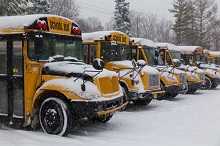With some pre-planning, schools and districts can turn snow days into learning opportunities
 The latest winter storm to pound the Northeast left a foot or two of snow in its wake, in the process shutting down much of the tri-state region, limiting access to roads, flights, and, of course, preventing schools from opening.
The latest winter storm to pound the Northeast left a foot or two of snow in its wake, in the process shutting down much of the tri-state region, limiting access to roads, flights, and, of course, preventing schools from opening.
While the amount of snow needed for schools to close varies by region, there is no denying that excessive snow days have begun to bleed into summer vacation over the past few years. Luckily, some school administrators have found a new approach to end snow days for good.
The solution is called “e-learning days,” or days dedicated to doing schoolwork over the internet.
E-learning brings massive benefits to any school district. They have the potential to save schools lots of money—buses don’t need to be deployed extra days at the end of the year, the school building doesn’t need additional heating, and hourly staff have the day off. Online learning also helps teachers reduce their stress load. It provides a predictable avenue for educators to budget their curriculum goals with available teaching days. Finally, e-learning days provide students with academic consistency and predictability, eliminating any snow day confusion.
E-learning is already becoming increasingly popular. Twenty-seven states offer online classes and 24 states (along with the District of Columbia) offer full-time virtual schools—as many as one million children in K-12 are already participating in these programs. Many well-respected schools are quickly making use of e-learning, including Stanford University Online High School, VISNet, and Laurel Springs. It’s time for e-learning to become common place in public schools, starting with snow days.
Of course, detractors are quick to point out that not every school can provide a virtual alternative to in-person instruction. Their most potent point is that not every child has equal access to the internet. For example, as of 2013, 75.6% of American households had a computer in the home and 71.7% had Internet access. The two largest age demographics of those with internet access are generally the same age of those raising children in K-12—18- to 29-year-olds (80%) and 30- to 49-year-olds (78%).
(Next page: 6 steps to put e-learning days into practice at your school)
While relying on the internet to facilitate e-learning days is realistic for a strong majority of school districts, it could still mean abandoning one-in-five students nationwide. Perhaps that’s why Illinois, Indiana, Ohio, Pennsylvania, and West Virginia are the only states to provide e-learning options for their public schools to date.
Indiana’s Department of Education requires that all districts participating in e-learning days “can prove all students and teachers have the ability to access the Internet when they are away from the school building.” Indiana has several other standards for teachers and students, including requirements for IEPs, and acts as a great reference that can be consulted nationwide.
There are six simple steps to introducing e-learning days to replace snow days in your district.
1. Check with your state legislators and teachers’ unions about school day minimums and allowable teaching hours. Make sure that, legally, e-learning days are a possibility for your district.
2. Ensure that both students and teachers have internet access at home. If not, try to work with parents and budgets to provide special tools or dispensations for disadvantaged kids. If nothing can be done, abandon the e-learning program.
3. Pick out the best learning management system for your school—ideally one that syncs with your school administration software.
4. Establish a time when students should start working and should have completed their work—ideally later than normal so that teachers will have time to prepare their lessons for the day.
5. Train your teachers on e-learning best practices. Figure out what works best for your school—should your teachers record their lectures at home? Create interactive assignments? Teach at a specified time with webinars?
6. Test out what feels best for your school and teachers. Using an e-learning system has a learning curve, but one that’s well-worth the effort in saved days and money.
To be sure, e-learning doesn’t replace traditional classroom education, but it can create an environment where your school will thrive even in the worst weather.
Rachel Burger writes for Capterra’s School Administration blog.
- TC- What student choice and agency actually looks like - November 15, 2016
- What student choice and agency actually looks like - November 14, 2016
- App of the Week: Science sensor meets your smartphone - November 14, 2016

